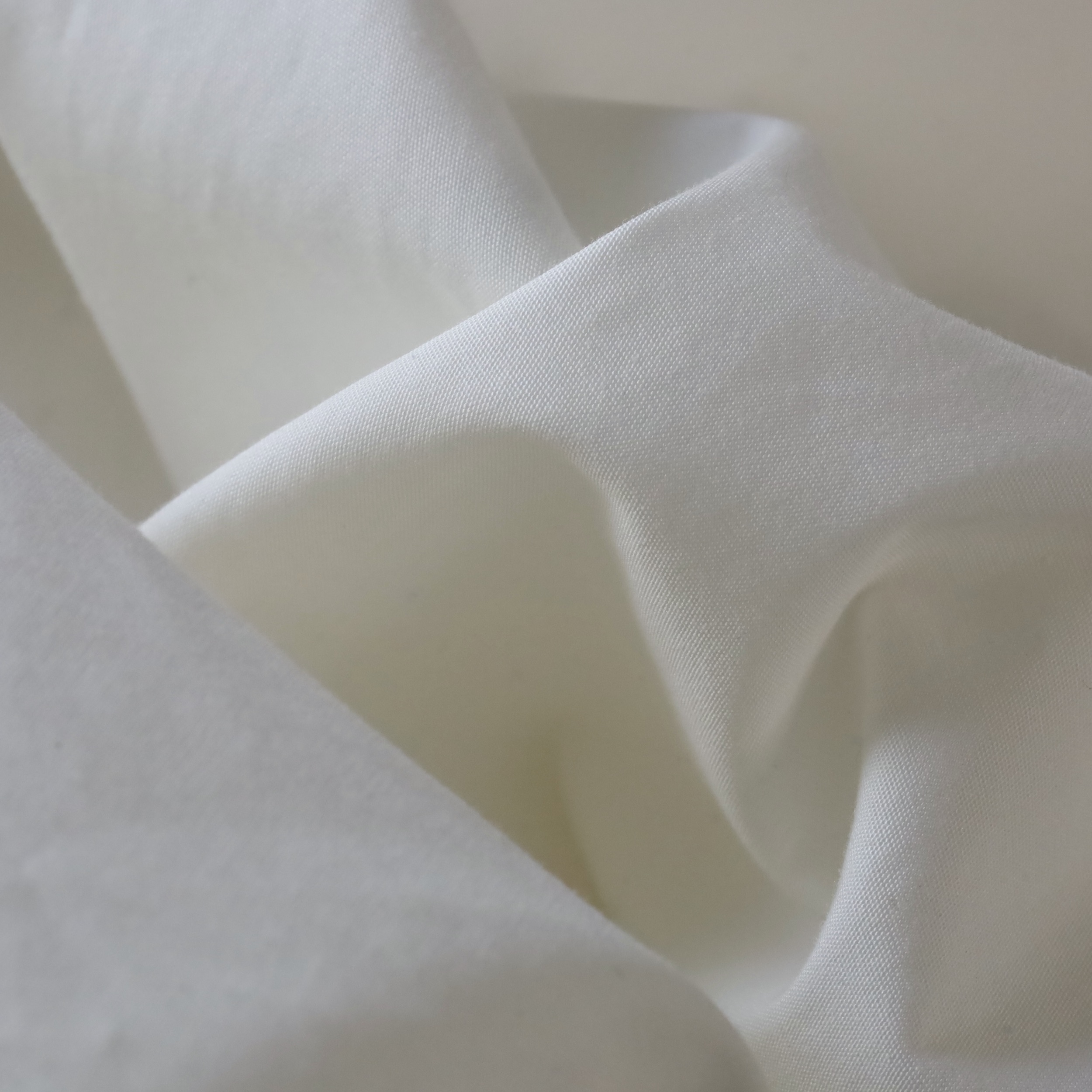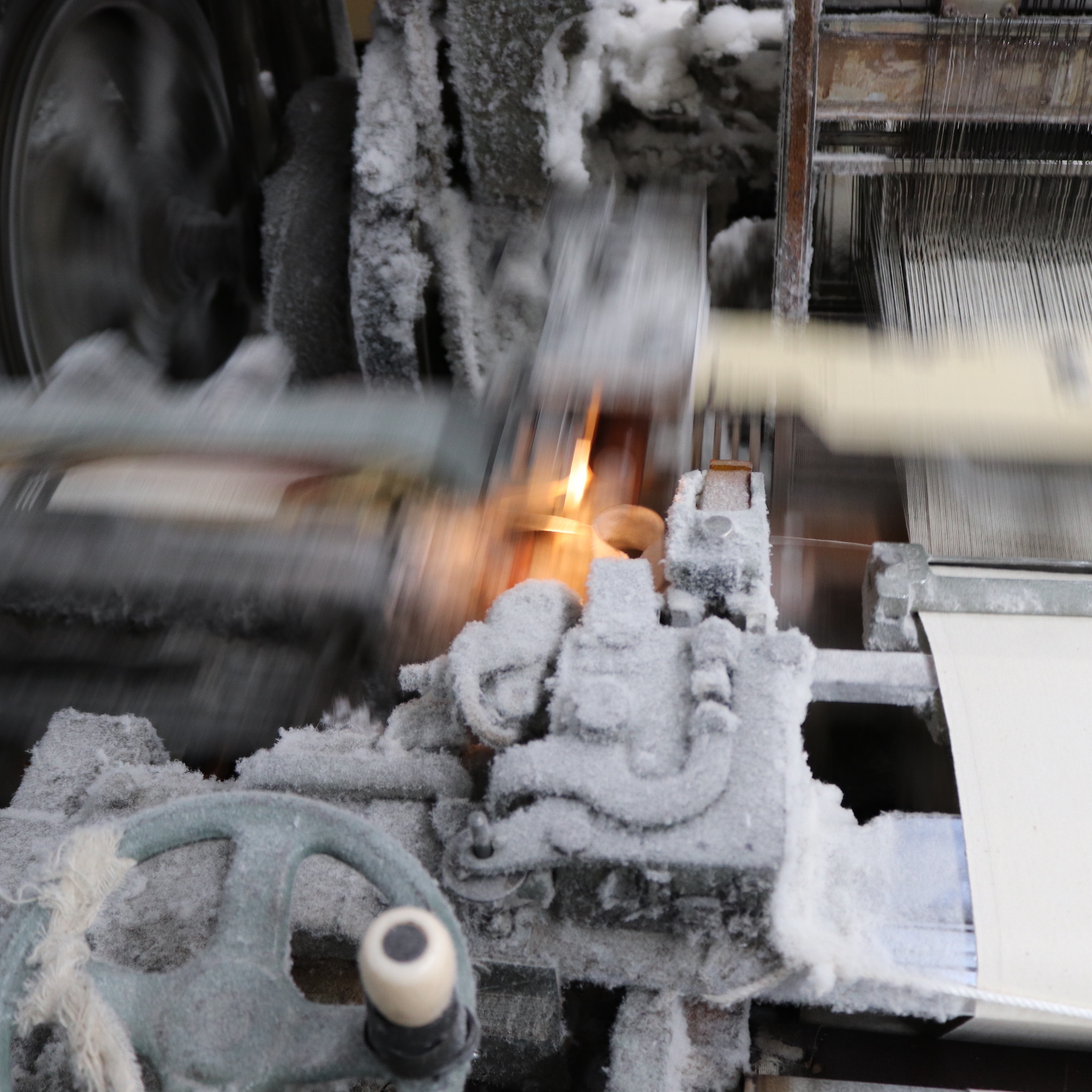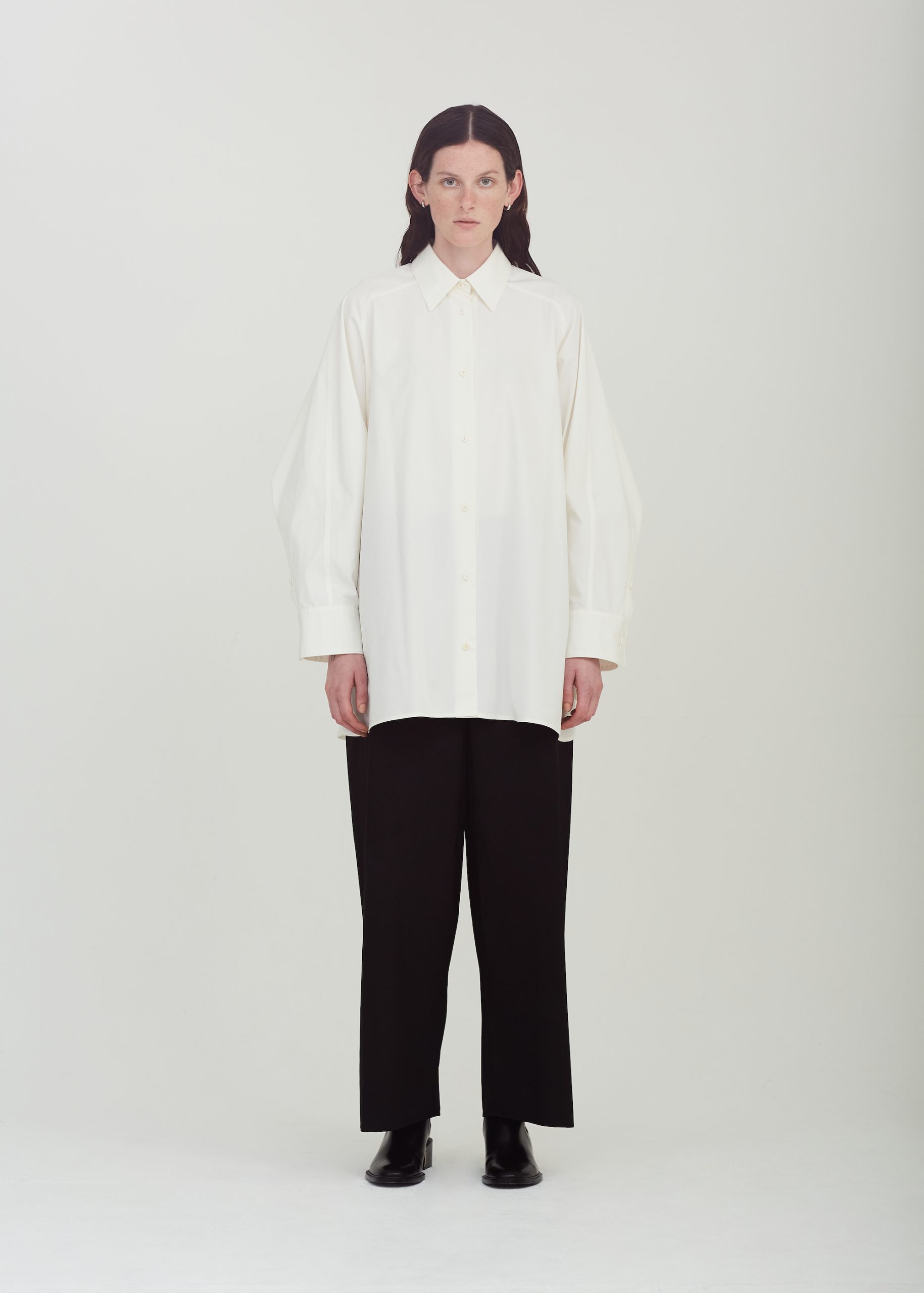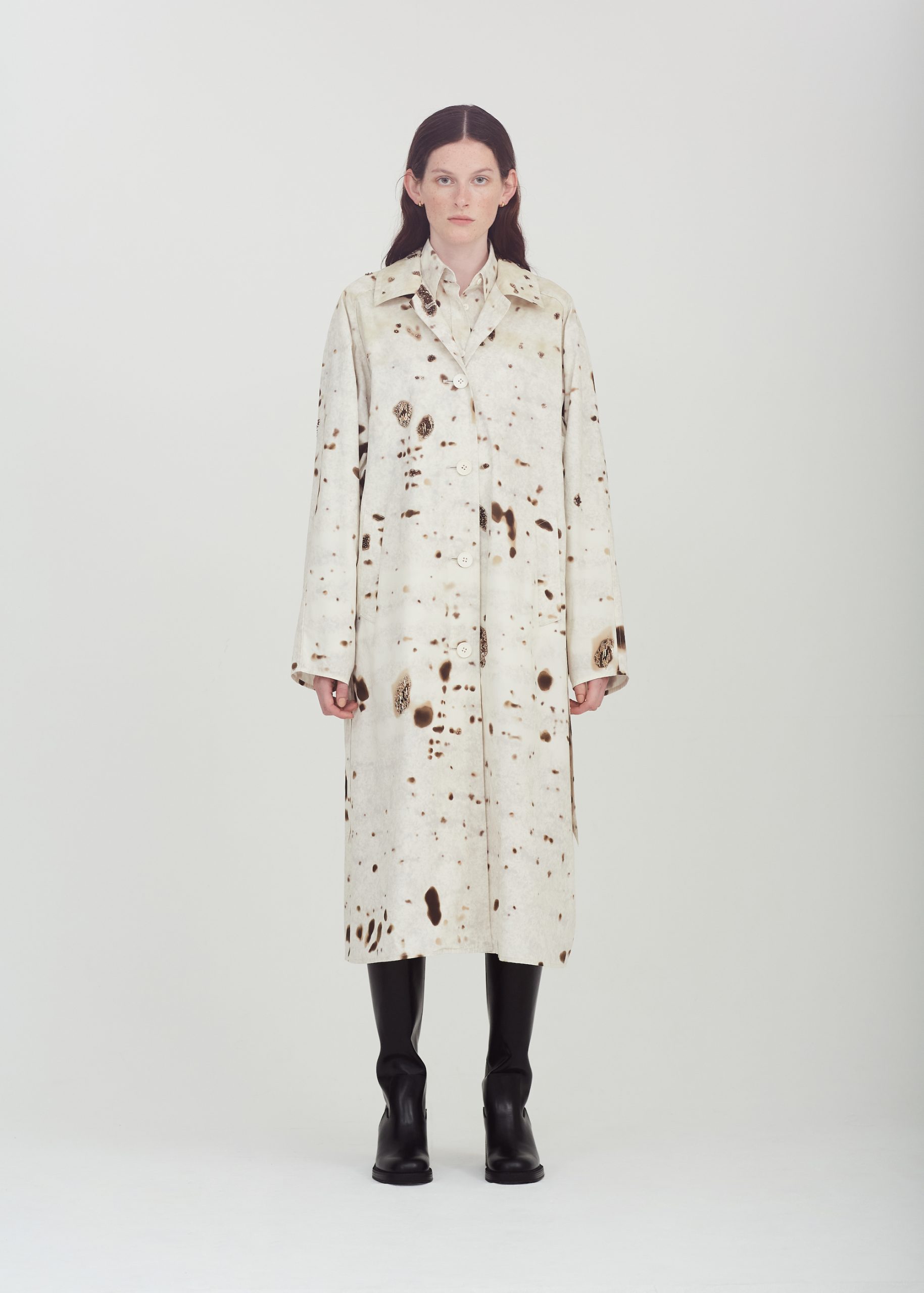AEHRR “現代の女性を支える綿100%織物” / AEHRR — 100% Cotton, Supporting the Modern Woman
2025.3.1
先日、紹介致しました”AEHRR (エアー)”。
杉原さん自身の”ドレーピングテクニック”、日本の屈指の機屋と行なう”オリジナル生地開発”。
この2つの要素が非常に高いレベルでマッチングすることで生み出されるAEHRRのコレクション。
その中でも、今日まずは、ブランドを象徴する生地”Heavy Broadcloth”について紹介を致します。
この生地は、誰もが見たことがある素材表記”綿100%”であっても、誰もが見たこと、触れたことのないと言えるほどの素材です。

こちら。
そして、この生地は、AEHRRの杉原さんが、「何のために洋服をつくるのか」ということを物語っている生地とも言えます。
まず、大きな特徴は、
“どれだけたくさんの回数着ても、家庭で洗濯機での洗濯を何度繰り返しても、生地が疲弊してしまうことがなく、新品時から美しさが損なわれることがない”
ということ。
また、加えて、
“生地が少しずつ自然に、身体に、肌に馴染んでいき、とても滑らかで優しいタッチとなっていく。その上で、AEHRRで設計されている洋服のフォルムを維持し続ける”
というものです。
デザイナーの杉原さんは、毎日毎日を社会でも、家庭でも、忙しく戦う”女性の支え”となれる洋服をつくることを目指しています。
言い換えると、「多忙な毎日と戦う女性の精神的なラグジュアリーを実現する一つの要素となるため」に洋服をつくっていると言える。
実物に触れると感じて頂けると思いますが、この素材であれば、朝出掛けるときに、パッと手に取って着ることができるほど非常にタフなもの。
それを着て、いつもの忙しい生活をしていて、不意に着ている服に目がいくとき。
そのときに、今自分が着ている服がシナシナでヘタヘタでくたびれてしまっていたら、きっとそれを着ている自分自身がもっと疲れる。
でも、その服が、生地がピンとしたハリがあって、活き活きしていたら、きっとそんなことにはならないんじゃないかと思います。
また、少し気分が落ち込んだ時、「明日AEHRRの服を着て頑張ろう」とか、「AEHRRの服を着てポジティブに過ごそう」などと思ってもらえるように。
という願いを込めて洋服づくりを行なっています。
だからこそ、着用回数が重なる度に、劣化の一途を辿ってしまう洋服であってはダメだし、型崩れをしてもダメ、せっかくAEHRRの洋服を手にしてもらったのであれば、見た目も着心地も、より良さを感じ続けてもらえるものを。と考えている。
AEHRRの杉原さんが設計した形が損なわれることなく、型崩れをしてしまうことなく、いつも美しいフォルムを演出してくれる生地であり、洋服。
日々、”戦う女性を見た目だけでなく、精神的な内面の部分を支えられる”。そんな洋服でありたい。
と、まさにAEHRRを象徴し、上記の通り、AEHRRの杉原さんが何のために洋服をつくり、皆様に届けたいのか。ということをとても物語っている生地となります。

こちら。
強いハリと、キメが細かく、整った生地表面。そして、柔らかく自然な光沢。
ここから少し具体的に紹介をさせて頂きます。
混率でいうと”コットン100%”で、組織は平織りである。
しかし、一般的に流通しているコットン100%の織物とは、生地のタッチ、見た目、着心地がまるで異なります。
これには、皆様、是非驚いてください。
しかも、先述のように、それが新品の状態だけではなく、手にした3ヶ月後、半年後、1年後、3年後、、、と着続けていくほどに、もっともっと如実に感じられるようになってくる生地。
原料となるコットンは、インド産の超長綿(繊維長3.5cm以上)。
そもそもコットン繊維には、科学者の交配により、世界で110種類以上の数が存在すると言われているようですが、これまで何年にもわたって、たくさんの生地開発を行なってきた杉原さんである。
110種類以上あるコットンの中でも、インド産超長綿を原料に100%使っていることにも理由がある。
それは、織り上げた生地の風合いや、完成した時の洋服の姿、更には、それが年月を経た後の様子を逆算し、原料の段階で数多くの想定を行ないます。
その目指すゴール地点に辿り着くためには、いろんな技術力が必要となるのですが、糸そのものの毛羽立ちを抑える為の”ガス焼き”という工程や、紡績した糸に、更に撚りを加える追撚での”強撚”を施した糸の状態、生地の”密度”や”生地組織”の計算など、様々なこと。
そのような多様な側面から導き出されたベストな原料が、”インド産の超長綿”なのである。
多くの場合、超長綿を原料に使用するのであれば、その長い繊維ゆえ、特性を活かして、細い糸に紡績をするのが”良いもの”とされている。例えば100番手とか、120番手など。
しかし、AEHRRでは、その原料を”35番手”という独特で、太い糸に仕上げ、その糸を単糸という”一本の糸”で経糸・緯糸ともに使用している。
加えて、このインド産超長綿、35番手単糸、平織り生地を織り上げている機屋さんがまた凄まじいのだ。

静岡県掛川市に位置する”カネタ織物株式会社”である。
綿織物の分野で、日本で唯一無二の存在の機屋さんではないかと僕は思っている。
綿織物に対して追究し続ける情熱、開発力、技術力。知れば知るほどに、痺れる機屋さんである。
得意とするものは、もちろん”綿100%”の生地。
それも、途轍もないクオリティの”高密度生地”を織り上げるのだ。
何度も言うように、コットン100%の生地というのは、世の中に星の数ほど存在する。
でも、カネタ織物さんでつくるAEHRRの生地は、絶対に同じレベルのものが存在しない。

カネタ織物さんでは、生地を織り上げる織機は、その多くが”シャトル織機”で占める。
もう現在は生産がされていない古い織機であり、手織りに最も近い構造のものである。
イギリスの産業革命で誕生した織機であり、それまでは手織りの時代であった。
シャトル(杼)がハンマーで叩かれるかのようにして、セットされた経糸の間を通ることで一本ずつ緯糸が打ち込まれる超アナログ構造な織機。
シャトルが左右を繰り返し往復するため、生地の両サイドである”生地ミミ(セルヴィッチ)”が構成されるもの。
他の織機(レピア織機は、糸が一方通行に打ち込まれるのだが、織機の片側から出てくるレピアが緯糸を運び、セットされた経糸の中央で、もう一方から出てきたレピアにバトンタッチするようにして生地の端まで糸を運び緯糸を打ち込む。非常に量産的なエアジェット織機やウォータージェット織機だと空気の力、水の力で織機の左端から右端まで一気に飛ばされ、緯糸が通ると左端で切断され、目にも止まらぬどころか、全く目視できないほどの速さで次々に緯糸が差し込まれていく。)では、それはない。
シャトル織機は、機械というよりは”道具”的な感覚に限りなく近いため、出来上がる生地も非常に幅が狭いことが特徴でもある。
一般的に布帛(織り生地)は、140cm前後のダブル幅のものが主流であるが、カネタ織物さんはシャトル織機であるため、生地の幅はシングル幅しかない。
だが、シャトル織機の改造することにより、本来のシングル幅であれば、生地幅は大体80cm前後であるが、中には110cmの幅で織り上げることができるシャトル織機も持っているそうだ。
そして、この”シャトル織機”をメインで使っているということが大きなポイントである。
シャトル織機は、生産効率も高いものではないため、現在主流のエアジェット織機、ウォータージェット織機と比べ、生産量は格段に少ない。
また、その上、先ほどの”生地幅”が広くないのだ。
生地幅が広くない上に、生産効率が決して高くない。
加えて、生地単価というものは、1mあたりで価格が決まり、それが商品の販売価格に直結するが、1m×140cm(ダブル幅)の生地と、1m×80cm〜110cm程度の生地だと、当然後者の方が割高になる。
だから、カネタ織物さんは、どうしても他社の生地よりも生地単価が高くなってしまう不利な条件がある分、そうであれば、シャトル織機を駆使して、絶対にカネタ織物でしかできない生地をつくろうということに情熱を注いでる。
非常に深くまで、”綿織物の世界”で、とにかく徹底的にクオリティの追究を行なっているのだ。

具体的に比較をすると、コットン100%という生地は、無数に存在するからこそ、その分、無数に”後加工”という方法が存在します。
特に優れた原料でなく、スピーディーに量産的につくられた綿100%の生地であっても、新品ではある程度は綺麗に見えるもの。
それは、最初は”化粧”をしている状態とも言える。
しかし、そのような”化粧が施された綿100%の生地”を洗濯をしたり、ある程度の期間着用しているとどうなるか。
みるみるうちに、化粧が落ちて、素の状態が露わになり、残念に思ってしまうことがあるのではないかと思います。
対して、カネタ織物さんでつくる生地は、上記のような後加工は、ほとんどの場合、必要最低限にしか行なうことがないそうです。
原料の良さ、糸の良さ、織り設計の良さで、ダイレクトに勝負をしてる生地なのである。
だからこそ、新品の状態でも綺麗な生地ではあるが、使うほどにカネタ織物さんの生地は、そのものの良さが溢れてくる。
このことはきっと、手にして頂けた皆様、誰もにそう感じてもらえると確信しています。
その上、杉原さん自身もこれまでに数多くのすごいレベルの生地を開発してきた経験値があり、この両者が本気で向き合うことで、世の中にない綿100%の生地ができているのです。
紡績の方法も、糸の太さも、生地の織り構造も、他に存在しない方法を導き出して、形にしているもの。
杉原さんのために、カネタ織物さんが圧倒的な技術力で導き出した方法です。
それだからこそ、世界で、いや、宇宙で、唯一の綿100%織物、”Heavy Broadcloth”が完成しています。





上記のルックが”Heavy Broadcloth”を使用したコレクションの一部となります。
ドレーピングにより設計したアウトラインを描き続ける生地のハリ、生地そのものの美しさ。
そして、それが使い続けて頂くことで、一層の魅力を感じて頂けるはずです。
僕は、本来、洋服というものは着飾るだけではなく、着用する人の心、精神性に訴えかけるような作用があるものだと思っています。
いわばそれは、杉原さんは、ものづくりに全身全霊で向き合うことで、つくり手として、AEHRRの洋服を着用する女性と、精神面でのコミュニケーションをとれることを目指しています。
これから納品されるAEHRRの洋服を通して、手にして頂けた方々に、時間をかけてゆっくりとAEHRRの洋服づくりを感じて頂けたら幸いです。
LE BERGER / Herd Limited.
shop talk & communications by Akihiko Fukuda
__________
The English translation is as follows:
Previously, I introduced “AEHRR.”
At the core of AEHRR’s craftsmanship lies Sugihara’s draping technique and the development of original fabrics in collaboration with Japan’s top textile mills.
By achieving an exceptionally high level of synergy between these two elements, AEHRR creates garments that are truly unique.
Today, I would like to introduce one of the brand’s signature fabrics, “Heavy Broadcloth.”
Although it carries the familiar material label “100% Cotton,” this fabric is unlike anything you have ever seen or touched before.
This fabric can be seen as a direct reflection of why AEHRR’s designer, Atsushi Sugihara, creates clothing.
Key Features of AEHRR’s “Heavy Broadcloth”
- No matter how many times you wear it or wash it in a household washing machine, the fabric will never deteriorate or lose its original beauty.
- Over time, the fabric naturally conforms to the body and skin, becoming exceptionally smooth and gentle to the touch, all while maintaining the carefully designed AEHRR silhouette.
Sugihara designs to support women who fight through their busy lives—both at work and at home—every single day.
In other words, his goal is to create garments that serve as an element of “mental luxury” for women facing demanding daily routines.
When you feel the fabric in person, you’ll understand how effortless it is to throw on in the morning—a tough, durable material that withstands daily wear with ease.
Then, during a long and busy day, there may be moments when you suddenly become aware of the clothes you’re wearing.
If at that moment, the fabric feels worn-out, limp, or lifeless, it might make you feel even more exhausted.
But if the fabric remains structured, full of life, and holds its shape beautifully, it may quietly uplift and energize you.
Sugihara creates clothing with the hope that, when someone is feeling down, they might think,
“Tomorrow, I’ll wear AEHRR and give it my best,” or
“Wearing AEHRR will help me stay positive today.”
For this reason, AEHRR garments must not deteriorate over time, nor should they lose their shape.
If someone chooses to invest in AEHRR, Sugihara wants them to continue feeling its beauty and comfort every time they wear it.
AEHRR’s “Heavy Broadcloth” is a fabric that ensures the garment’s structure remains intact, always presenting a beautiful silhouette without losing its form.
This is not just about appearance—it’s about supporting women not only on the outside but also emotionally and mentally.
This fabric, more than anything, embodies the essence of AEHRR—a direct expression of why Sugihara creates clothing and what he hopes to deliver to those who wear it.
Strong Structure, Ultra-Fine Texture, and a Natural Soft Sheen
Let’s delve deeper into the specifics of this extraordinary fabric.
At its core, this material is labeled as “100% Cotton”, woven in a plain weave structure.
However, it is entirely different in touch, appearance, and comfort from the typical 100% cotton fabrics found in mainstream circulation.
This is something that I truly encourage everyone to experience and be amazed by.
And as mentioned earlier, this uniqueness is not just evident when new—rather, over time, as you wear it for three months, six months, a year, or even three years, you will notice its distinct evolution and refinement.
The Raw Material: Indian Extra-Long Staple Cotton
There are reportedly over 110 different types of cotton worldwide, developed through scientific crossbreeding.
Sugihara, having spent years developing numerous fabrics, has extensively researched and experimented with different cotton varieties.
Among them, he chose to use 100% Indian Extra-Long Staple Cotton (ELS) as the base material.
Why?
Because before the fabric is even woven, extensive considerations are made regarding:
- How the finished fabric will feel and drape
- How the garment will look when completed
- How the fabric will age and evolve over time
Every step is meticulously planned to achieve the ultimate goal, which requires a range of advanced techniques.
These include:
- “Gas burning” (gassing) – A process that removes excess fuzz from the yarn to achieve a clean, smooth surface.
- “Extra twisting” (high-twist yarn) – Adding additional twists to the spun yarn to enhance durability and create a strong, resilient structure.
- Precise calculations of fabric density and weave structure – Ensuring the perfect balance between durability, structure, and comfort.
Through these extensive considerations, the best possible raw material was identified: Indian Extra-Long Staple Cotton.
A Radical Approach to Yarn Selection
In most cases, when using Extra-Long Staple Cotton, it is considered “high-end” to spin it into fine-count yarns—such as 100s or 120s—to create a delicate, refined fabric.
However, AEHRR takes an entirely different approach.
Instead of spinning it into fine yarns, AEHRR boldly uses a 35-count yarn, which is significantly thicker than the industry standard.
Moreover, both the warp and weft threads are woven using a single-ply yarn (monofilament), rather than the commonly used two-ply or multi-ply yarns.
The Weaving Mill Behind the Fabric
On top of this, the textile mill responsible for weaving this fabric is nothing short of exceptional.
Their craftsmanship, expertise, and attention to detail allow for the creation of a fabric that cannot be replicated anywhere else.
The result? A cotton fabric that defies expectations—one that feels different, wears differently, and evolves uniquely over time.
The weaving mill responsible for this extraordinary fabric is Kaneta Textile Co., Ltd., located in Kakegawa City, Shizuoka Prefecture.
In the field of cotton textiles, I believe Kaneta Textile is truly one of a kind in Japan—a weaving mill with no equal.
Their passion, innovation, and technical expertise in cotton fabric development are simply remarkable. The more you learn about their work, the more you become deeply fascinated by their craft.
Masters of High-Density Cotton Weaving
Kaneta Textile specializes in “100% Cotton” fabrics, but their true expertise lies in weaving exceptionally high-density textiles of unmatched quality.
As I have mentioned before, there are countless 100% cotton fabrics in the world. However, the cotton fabric produced by Kaneta Textile for AEHRR is unparalleled—it is at a level that simply does not exist anywhere else.
The Shuttle Loom: The Heart of Kaneta Textile’s Craftsmanship
At Kaneta Textile, most of the looms used for weaving fabrics are shuttle looms.
These are old, no longer manufactured machines, yet they remain the closest to hand-weaving in their construction and operation.
Shuttle looms were first introduced during Britain’s Industrial Revolution, marking the transition from hand-weaving to mechanized weaving.
However, their mechanism is highly analog and traditional—a shuttle is propelled back and forth like a hammer striking, passing through the warp threads one pick at a time, inserting the weft thread.
Since the shuttle moves in a continuous back-and-forth motion, the fabric naturally forms “selvedge edges” on both sides, a feature unique to shuttle-woven textiles.
How Shuttle Looms Differ from Modern Industrial Looms
In contrast, other industrial looms operate very differently:
- Rapier looms transport the weft yarn in a single direction, using two carriers (rapiers) that meet in the middle and pass the thread from one to the other.
- Air-jet and water-jet looms, used for high-speed mass production, propel the weft yarn using air or water pressure, instantly inserting the thread from one end to the other. In these machines, the weft is cut at the edges, resulting in fabrics without selvedge.
The Characteristics of Shuttle-Woven Fabric
One defining feature of shuttle-woven textiles is their narrow width.
While most woven fabrics today are approximately 140cm wide (double-width), Kaneta Textile’s fabrics, woven on shuttle looms, are single-width.
Typically, shuttle-woven fabrics have a width of around 80cm, but Kaneta Textile has modified their looms to produce fabrics up to 110cm wide—a rare capability.
The Challenges and Commitment of Using Shuttle Looms
Despite the many limitations of shuttle looms, Kaneta Textile continues to use them as their primary weaving machines.
Shuttle looms are:
- Far less efficient than modern air-jet and water-jet looms.
- Slower in production, leading to a lower fabric yield.
- Narrower in width, making it more expensive per meter compared to double-width fabrics.
Since fabric prices are calculated per meter, a 1m × 140cm (double-width) fabric is much more cost-effective than a 1m × 80-110cm (single-width) fabric.
This means that Kaneta Textile’s fabrics inherently have a higher cost per meter compared to mass-produced alternatives.
Why Kaneta Textile Continues to Weave with Shuttle Looms
Rather than competing in mass production, Kaneta Textile focuses on what only they can do.
They dedicate themselves to pushing the limits of quality in cotton textiles, ensuring that their fabrics offer an unparalleled level of craftsmanship and depth.
By fully embracing the strengths of shuttle looms, they create fabrics that cannot be replicated anywhere else.
Their commitment is not about speed or cost-efficiency—it is about crafting the absolute best cotton fabrics possible.
A True Comparison: The Difference Between Ordinary Cotton and Kaneta Textile’s Heavy Broadcloth
Since 100% cotton fabrics exist in countless variations, there are equally countless ways to enhance them through post-processing.
Even cotton fabrics made from average raw materials and produced in mass quantities can appear clean and beautiful when brand new.
However, this initial appearance is often the result of heavy processing and artificial treatments—akin to applying makeup to fabric.
What Happens to Mass-Produced Cotton Over Time?
When such “makeup-treated” cotton fabrics are washed or worn for a period of time, the artificial finish begins to fade.
- The original raw quality of the fabric is revealed.
- The fabric loses its freshness and vitality.
- It may no longer look as refined as it once did, leading to disappointment.
The Kaneta Textile Difference: No Excessive Processing, Pure Material Integrity
In contrast, the fabrics woven at Kaneta Textile require minimal post-processing.
Their philosophy is not to rely on artificial treatments but instead to let the natural quality of raw materials, yarn, and weaving techniques speak for themselves.
Because of this approach:
- The fabric looks stunning when new.
- Over time, it becomes even more beautiful with use—not deteriorating, but revealing deeper richness and texture.
I am confident that anyone who owns this fabric will experience and appreciate this transformation.
A Collaboration That Creates the Impossible
Sugihara has extensive experience in developing some of the highest-quality fabrics in the industry.
When Kaneta Textile’s technical mastery and Sugihara’s design vision come together, the result is a 100% cotton fabric unlike anything else in the world.
- The spinning method
- The yarn thickness
- The weaving structure
All of these have been reimagined, reinvented, and executed in ways never seen before.
Kaneta Textile has pushed the limits of their craftsmanship to create a fabric that could not exist without this partnership.
A Fabric Unlike Any Other in the World—Or Even the Universe
This is why AEHRR’s Heavy Broadcloth is not just another cotton fabric—it is a one-of-a-kind textile, unparalleled in the industry. Not just world-class, but perhaps even the only fabric of its kind in the universe.
A Glimpse into AEHRR’s Heavy Broadcloth Collection
The looks featured in these photos are part of AEHRR’s collection crafted from Heavy Broadcloth.
This fabric maintains its structured silhouette, staying true to the draped outlines meticulously designed through the draping technique.
Its natural luster and firmness enhance the beauty of the fabric itself, while also ensuring that the garment continues to evolve and grow even more beautiful over time.
Beyond Clothing: A Deeper Connection
I believe that clothing is not merely for adornment—it has the power to resonate with the wearer’s emotions and spirit.
In this sense, Sugihara devotes himself wholeheartedly to his craft, creating garments that go beyond the physical form.
Through AEHRR, he seeks to establish a deep, spiritual dialogue between the creator and the women who wear his designs.
A Journey Through Time with AEHRR
As AEHRR’s garments begin to reach the hands of their wearers, my hope is that each person will take the time to slowly experience and appreciate the essence of AEHRR’s craftsmanship.
With every wear, the garments will not only retain their striking form but will also become a part of the wearer’s personal journey—transforming and evolving along with them.
